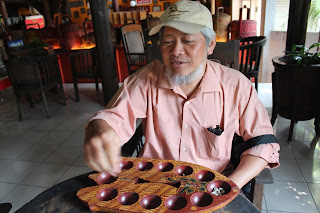Getting rich, getting
burned: Playing with our heritage
Or maybe a Maori waka the
huge war canoes that carried skilled navigators across the South Pacific to
make a new home in Aotearoa – which is now New Zealand
But what have Norse raiders who invaded and plundered
Northern Europe 1,100 years ago, and Polynesians of about the same era got to
do with the world’s largest archipelago?
Step closer to the sideboard and be rewarded.
Dakon boards are
impressive artefacts and works of art, much loved by modern home designers keen
to add a touch of local culture to their minimalist décor. They are not boats but ancient games that
many Indonesians raised before smart phones knew well.
A dakon board is
usually a long and substantial hunk of carved hardwood with two parallel sets
of holes or cups gouged along the top.
These hold small cowrie shells or seeds, often tamarind, though anything
small and smooth will do.
The finest are made by backyard craftsmen, though smaller
mass-produced portable fold-up versions are now being sold in gift shops.
The idea of playing the game by ‘sowing’ the seeds [See
Breakout] and acquiring storehouses suggests links with agriculture, maybe a
diversion when it was too hot to work the fields.
The game is not
exclusive to Indonesia and may have come from North Africa where archaeological
evidence goes back to the sixth century AD. There are records of similar games
in Europe but it seems they were not as popular as chess, which probably
originated in India about the same time.
Other names are
sungka [Philippines] and congkak [Malaysia]. Scientists, who like to classify everything,
have labelled dakon as a mancala game after the Arabic word naqala, meaning ‘to move’. The easiest definition is that dakon is a ‘count-and-capture’ game.
Some dakon boards are plain
and functional, but many have been elaborately carved and painted to show off
their splendid lines and Janus-like heads of birds or dragons. In some versions, like those from Madura,
the heads can be removed and turned around.
The late Dutch curator Jan Thomassen à Thuessink van der Hoop, an authority on Indonesian design, suggested some figures represent the Panakawan, the comic characters in Javanese wayang [shadow puppetry].
Because of their weight and dimensions dakon boards fit just fine on the top of a buffet where they’ll become the talking point to impress guests. They are not associated with black magic or religious rites so there’s no chance of causing offence.
“There’s a long and complex provenance here that’s firmly rooted in Southeast Asia and Indonesia in particular,” said cultural analyst Ismail Lutfi, a senior lecturer in history at Malang State University.
“I learned to
play dakon as a very small child when
I grew up in the small village of Klaten in Central Java, not far from the kraton [royal palaces] of Yogyakarta and
Solo.
“My strong
assumption is that the game was played by the nobles’ children and then passed
on to the ordinary people. If they
didn’t have a dakon board they
improvised by using floor tiles or just scratched out a pattern in the dirt.
There are references to the game in Sir Stamford Raffles’ The History of Java.
“The game was
also played by diplomats; because many knew a version they had something in
common with their foreign counterparts.
This helped establish relationships.
“It was a
common pastime which provided a wealth of learning. Dakon which is also
known in Java as dhakon and congkak [or congklak] teaches mathematics, the logic of strategy, morality and
self-control. It’s also about the
consequences of cheating.”
Lutfi said that
in the past parents and other adults in the family used dakon to train children to manage their lives so they could enjoy
prosperity. It could also be seen as a
war game with the opponent as an enemy who had to be overcome.
“This is why
words like bedil [rifle] are used
when you destroy an opponent’s seeds,” he said.
“Anyone who
thinks this is a kids’ game, or just something for the girls, is sadly
mistaken. This is part of our
intangible heritage.”
How to play
How to play
Normally two
people play, usually facing each other
either side of the board which may have up to nine holes, or cups on
either side. These are often called anak [child] with a larger one at
either end known as Ibu
[mother]. These are the storehouses.
The plan is to
fill your storehouse with more seeds than your rival.
Seven seeds or
shells are placed in each anak,
though five may be used on smaller boards. One gamer starts by scooping up the
contents from an anak and dropping
them one-by-one in each cup and the player’s own storehouse.
The
distribution includes the opponent’s anak
though not their storehouse. The players work their way clockwise around
the board.
The idea is to
get the last seed to drop into your storehouse. This entitles you to keep going by recharging your hand from
another one of your anak.
However if the
last seed drops into an empty anak the
player is entitled to seize his or her opponents’ seeds from the cup opposite
and drop them into their own storehouse. Then it’s the other person’s turn to
play.
A seedless anak gets ‘burned’, or as some say in
East Java, ‘shot’ and is out of play.
Winners have
good memories, can calculate the number of seeds accumulated in any anak and know where they’ll be dropped.
Modern economists call this ‘forward planning’ and ‘resource conservation’.
There are You Tube clips on the Internet of
children explaining the game. Some are more confusing than others.
A video game
developer in South Kalimantan has a dakon
app which can be used on android devices.
There’s a free version and another which costs Rp 12,600 [US$ 1.0]. Reviews have been mixed.
First published in J-Plus, The Jakarta Post 6 September 2015





No comments:
Post a Comment